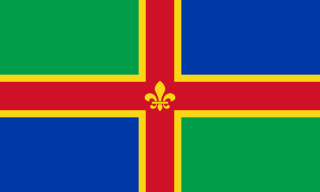
Lincolnshire is a county in eastern England, with a long coastline on the North Sea to the east. It borders Norfolk to the south east, Cambridgeshire to the south, Rutland to the south west, Leicestershire and Nottinghamshire to the west, South Yorkshire to the north west, and the East Riding of Yorkshire to the north. It also borders Northamptonshire in the south for just 20 yards (18 m), England's shortest county boundary. The county town is the city of Lincoln, where the county council has its headquarters.

The Midlands is an area of central England that borders the South East, South West, North West, East of England and Yorkshire and the Humber. Its largest city is Birmingham. Broadly corresponding to the early medieval Kingdom of Mercia, it was important in the Industrial Revolution of the 18th and 19th centuries. The Midlands are split between the East Midlands and West Midlands, with East Anglia sometimes included.

Bolingbroke, now called Old Bolingbroke, is a village and civil parish in the East Lindsey district of Lincolnshire, England. The population at the 2001 census was 298 in 128 households. The parish population at the census 2011 had risen to 325.

West Lindsey is a local government district in Lincolnshire, England.
Robert Mannyng was an English chronicler and Gilbertine monk. Mannyng provides a surprising amount of information about himself in his two known works, Handlyng Synne and Mannyng's Chronicle. In these two works, Mannyng tells of his residencies at the Gilbertine houses of Sempringham and Sixhills, and also at the Gilbertine priory at Cambridge, St Edmund’s.

The Lincolnshire Wolds is a range of hills in the county of Lincolnshire, England. It is a designated Area of Outstanding Natural Beauty (AONB), and the highest area of land in eastern England between Yorkshire and Kent. They run roughly parallel with the North Sea coast, from the River Humber in the north-west to the edge of the Lincolnshire Fens in the south-east.
The ceremonial county of Lincolnshire is the second largest of the English counties and one that is predominantly agricultural in character. Despite its relatively large physical area, it has a comparatively small population. The unusually low population density that arises gives the county a very different character from the much more densely populated an urbanised counties of south-east and northern England, and is, in many ways, key to understanding the nature of the county.

The official flag of Lincolnshire was unveiled at five separate ceremonies across the county on 24 October 2005. The flag was chosen in a popular vote organised by BBC Radio Lincolnshire along with Lincolnshire Life magazine. The winning entry, designed by Lincolnshire-born Michelle Andrews, a web producer at BBC Lincolnshire, was selected from a shortlist of six designs and attracted thousands of votes.
Gwladys ferch Dafydd was the daughter of Dafydd ap Gruffudd, the last free Prince of Wales, and Elizabeth Ferrers. She probably spent most of her early life in the company of her father in England and Gwynedd.

Well is a small estate village and civil parish about 1.5 miles (2.4 km) south of the town of Alford, in the East Lindsey district of Lincolnshire, England. The population of the civil parish was 166 at the 2011 census. It is situated on the foot of the east entry to the Lincolnshire Wolds. The population of 166 as at the 2011 census includes the hamlet of Claxby St. Andrew. The village provides views of the gradually sloping hills towards the west.

Ludford is a village and civil parish in the East Lindsey district of Lincolnshire, England. The parish is composed of the villages of Ludford Magna and Ludford Parva.

Witham on the Hill is a village and civil parish in the South Kesteven district of Lincolnshire, England. The population of the civil parish was 260 at the 2011 census.

Welton le Marsh is a village and civil parish in the East Lindsey district of Lincolnshire, England. It is situated approximately 6 miles (10 km) north-east from the town of Spilsby and approximately 5 miles (8.0 km) south from the town of Alford. The hamlet of Boothby lies within the parish about 1 mile (1.6 km) east of Welton le Marsh village.

Claxby St Andrew, is a village and former parish about 3 miles (5 km) south of Alford, in the East Lindsey district of Lincolnshire, England. It is in the civil parish of Well.

North Willingham is a village and civil parish in the West Lindsey district of Lincolnshire, England. The population of the civil parish was 181 at the 2011 census. It is situated 3.5 miles (6 km) east from the town of Market Rasen on the A631 road between Market Rasen and Louth.
Thomas Moigne, of Willingham, Lincolnshire, was an English politician, executed for his part in the Lincolnshire Rising.
Charles Allix Wilkinson was an English clergyman and a cricketer who played in eight first-class cricket matches for Cambridge University, Norfolk and the Gentlemen between 1833 and 1835. He was born at Swaffham Prior in Cambridgeshire and died at Boxworth, also in Cambridgeshire.













